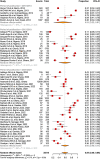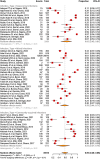Prevalence of multidrug-resistant bacteria in healthcare and community settings in West Africa: systematic review and meta-analysis
- PMID: 40022011
- PMCID: PMC11871699
- DOI: 10.1186/s12879-025-10562-w
Prevalence of multidrug-resistant bacteria in healthcare and community settings in West Africa: systematic review and meta-analysis
Abstract
Background: Multidrug-resistant (MDR) bacteria are a global health threat, notably in low- and middle-income countries. The aim of this review was to estimate the prevalence of multidrug-resistant bacteria in healthcare and community settings in West Africa.
Methods: In accordance with PRISMA guidelines, we searched PubMed, CINAHL, African Index Medicus, and other databases for studies published from 2010 onward. Data on MDR bacterial prevalence, study characteristics, and infection types were extracted and analyzed via R software. Subgroup analyses were performed to explore differences in prevalence across infection settings and sample types.
Results: Out of the 5,320 articles identified, 50 studies from 13 West African countries met the inclusion criteria, with the majority from Nigeria (34%) and Ghana (22%). Among the 35,820 bacteria isolated in these studies, gram-negative bacteria (GNB), particularly Escherichia coli and Klebsiella sp., were the most frequently isolated species, accounting for 63.3% of the bacteria. The overall prevalence of MDR bacteria was 59% (95% CI: 48-69%), with significant heterogeneity between studies (I² = 98%, p < 0.001). Subgroup analysis revealed a 7% increase in MDR bacteria prevalence from the first five-year period to the last two five-year periods, and a greater prevalence of MDR bacteria in nosocomial infections (65%, 95% CI: 45-81%) than in community-acquired infections (53%, 95% CI: 31-74%). The prevalence of MDR bacteria in mixed infection settings was 58% (95% CI: 44-71%). The MDR prevalence was highest in the urine samples (72%, 95% CI: 57-84%) and superficial skin samples (69%, 95% CI: 29-92%), whereas it was lowest in the nasopharyngeal samples (26%, 95% CI: 21-33%).
Conclusion: The high prevalence of MDR bacteria in West Africa underscores the need for strengthened infection control measures, improved surveillance, and stricter antibiotic use policies. Enhanced regional collaboration is essential to mitigate the spread of AMR in both healthcare and community settings.
Prospero registration number: CRD42023470363.
Keywords: MDR bacteria; Prevalence; West Africa.
© 2025. The Author(s).
Conflict of interest statement
Declarations. Ethics approval and consent to participate: Not applicable. Consent for publication: Not applicable. Competing interests: The authors declare no competing interests.
Figures











References
-
- OMS. Plan d’action mondial pour combattre la résistance aux antimicrobiens [Internet]. Genève: Organization mondiale de la Santé; 2016 [cited 2024 Oct 24]. 21 p. Available from: https://iris.who.int/handle/10665/249548
-
- O’NEILL J. Review on antimicrobial resistance: tackling drug-resistant infections globally: final report and recommendations. 2016 [Internet]. [cited 2024 Oct 24]. Available from: https://amr-review.org/sites/default/files/160518_Final%20paper_with%20c...
-
- Berthuim J, Miras M. La résistance aux antibiotiques: un enjeu de santé publique et économique. Bpi Fr Serv L’avenir; 2018.
-
- Global antimicrobial resistance and use surveillance. System (GLASS) report 2022. Geneva: World Health Organization; 2022. License: CC BY-NC-SA 3.0 IGO.
Publication types
MeSH terms
Substances
LinkOut - more resources
Full Text Sources
Medical
Miscellaneous

